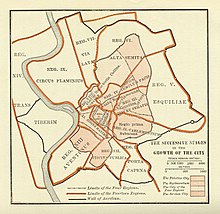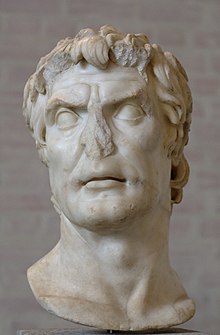Citizens' assemblies of the Roman Republic
Politics of ancient Rome |
|---|
 |
| Periods |
|
| Constitution |
| Political institutions |
| Assemblies |
|
| Ordinary magistrates |
| Extraordinary magistrates |
| Public law |
| Senatus consultum ultimum |
| Titles and honours |
The legislative assemblies of the Roman Republic were political institutions in the ancient Roman Republic. According to the contemporary historian Polybius, it was the people (and thus the assemblies) who had the final say regarding the election of magistrates, the enactment of Roman laws, the carrying out of capital punishment, the declaration of war and peace, and the creation (or dissolution) of alliances. Under the Constitution of the Roman Republic, the people (and thus the assemblies) held the ultimate source of sovereignty.
Since the Romans used a form of
In the Roman system of direct democracy, two primary types of gatherings were used to vote on legislative, electoral, and judicial matters. The first was the Assembly (comitia), which was a gathering that was deemed to represent the entire Roman people, even if it did not contain all of the Roman citizens or, like the comitia curiata, excluded a particular class of Roman citizens (the plebs). The second was the Council (concilium), which was a gathering of citizens of a specific class. In contrast, the Convention was an unofficial forum for communication. Conventions were simply forums where Romans met for specific unofficial purposes, such as, for example, to hear a political speech. Voters always assembled first into Conventions to hear debates and conduct other business before voting, and then into Assemblies or Councils to actually vote.
Assembly procedure

There were no set dates to hold assemblies, but notice had to be given beforehand if the assembly was to be considered formal. Elections had to be announced 17 days before the election took place. Likewise, 17 days had to pass between the proposal of legislation and its enactment by an assembly.[1]
In addition to the presiding magistrate, several additional
On the day of the vote, the electors first assembled into their conventions for debate and campaigning.
The electors were then told to break up the Convention and assemble into the formal Assembly or Council. The electors voted by placing a pebble or written ballot into an appropriate jar.[4][8] The baskets that held the votes were watched by specific officers, who then counted the ballots, and reported the results to the presiding magistrate. The majority of votes in any Curia, Tribe, or Century decided how that Curia, Tribe, or Century voted. Each Curia, Tribe, or Century received one vote, regardless of how many electors each Tribe or Century held. Once a majority of Curiae, Tribes, or Centuries voted in the same way on a given measure, the voting ended, and the matter was decided.[9]
If a law was passed in violation of proper procedures (such as failing to wait 17 days before voting on a law), the Senate could declare the law nonbinding.[10]
Assembly of the Curiae
The Curiate Assembly (comitia curiata) was the principal assembly during the first two decades of the
Shortly after the founding of the republic, most of the powers of the Curiate Assembly were transferred to the
Assembly of the Centuries

The Centuriate Assembly (comitia
The Centuriate Assembly was supposedly founded by the legendary

In 241 BC, the assembly was reorganized, though the exact details are uncertain. Some sources have a new total of 373 Centuries,[24] but Cicero still writes of 193 centuries in his era, and most scholars still use that number.[25] It is known that the first property class was reduced from 80 to 70 centuries, and the order of voting was changed so that the first class would go first, and be followed by the equites.[26]
The lowest ranking Century in the Centuriate Assembly was the fifth Century (called the proletarii) of the unarmed adjunct class. This Century was the only Century composed of soldiers who had no property, and since it was always the last Century to vote, it never had any real influence on elections.
During his
Assembly of the Tribes
The Tribal Assembly (comitia populi tributa) of the
In addition to the above-mentioned magistrates, the Tribal Assembly elected the
The thirty-five Tribes were not ethnic or kinship groups, but rather a generic division into which Roman citizens were distributed. When the Tribes were created the divisions were geographical, similar to modern
Plebeian Council
The Plebeian Council (concilium plebis) was the principal popular gathering of the
According to legend, the
The Plebeian Council elected two 'Plebeian Magistrates', the Plebeian Tribunes and the Plebeian Aediles.
See also
- Cursus honorum
- Byzantine Senate
- Princeps senatus
- Elections in the Roman Republic
- Interrex
- Procurator (Roman)
- Acta Senatus
- Tricameralism
Notes
- ^ Lintott, 44
- ^ a b Taylor, 63
- ^ Taylor, 96
- ^ a b Taylor, 2
- ^ Lintott, 45
- ^ Taylor, 16
- ^ Lintott, 46
- ^ Lintott, 46–47
- ^ a b Taylor, 40
- ^ Lintott, 62
- ^ a b c d Byrd, 33
- ^ a b c d e f Taylor, 3–4
- ^ a b Abbott, 250
- ^ a b Abbott, 253
- ^ Holland, 5
- ^ McCullough, 943
- ^ a b c Abbott, 257
- ^ a b Taylor, 85
- ^ Taylor, 87
- ^ a b Abbott, 21
- ^ E. S. Staveley. Greek and Roman Voting and Elections. Cornell University Press, 1972, p. 126.
- ^ Taylor, 86
- ^ Rachel Feig Vishnia. Roman Elections in the Age of Cicero: Society, Government, and Voting. Routledge, Mar 12, 2012, p. 113.
- ^ Abbott, 75
- ^ E. S. Staveley. Greek and Roman Voting and Elections. Cornell University Press, 1972, p. 127.
- ^ Rachel Feig Vishnia. Roman Elections in the Age of Cicero: Society, Government, and Voting. Routledge, Mar 12, 2012, p. 123.
- ^ Abbott, 107
- ^ Taylor, 7
- ^ a b c d Abbott, 261
- ^ Lintott, 51
- ^ Taylor, 77
- ^ Taylor, 76
- ^ a b Abbott, 196
- ^ Byrd, 31
- ^ Abbott, 51
References
- Abbott, Frank Frost (1901). A History and Description of Roman Political Institutions. Elibron Classics. ISBN 0-543-92749-0.
- Byrd, Robert (1995). The Senate of the Roman Republic. US Government Printing Office Senate Document 103–23.
- Cicero, Marcus Tullius (1841). The Political Works of Marcus Tullius Cicero: Comprising his Treatise on the Commonwealth; and his Treatise on the Laws. Vol. 1 (Translated from the original, with Dissertations and Notes in Two Volumes By Francis Barham, Esq ed.). London: Edmund Spettigue.
- Holland, Tom (2005). Rubicon: The Last Years of the Roman Republic. Random House Books. ISBN 1-4000-7897-0.
- Lintott, Andrew (1999). The Constitution of the Roman Republic. Oxford University Press. ISBN 0-19-926108-3.
- Polybius (1823). The General History of Polybius: Translated from the Greek. Vol. 2 (Fifth ed.). Oxford: Printed by W. Baxter.
- Taylor, Lily Ross (1966). Roman Voting Assemblies: From the Hannibalic War to the Dictatorship of Caesar. The University of Michigan Press. ISBN 0-472-08125-X.
- McCullough, Colleen (1990). The First Man in Rome. Avon Books. ISBN 0-380-71081-1.
Further reading
- Cambridge Ancient History, Volumes 9–13.
- Cameron, A. The Later Roman Empire, (Fontana Press, 1993).
- Crawford, M. The Roman Republic, (Fontana Press, 1978).
- Greenidge, Abel Hendy Jones (1911). . In Chisholm, Hugh (ed.). Encyclopædia Britannica. Vol. 6 (11th ed.). Cambridge University Press. pp. 763–765.
- Gruen, E. S. "The Last Generation of the Roman Republic" (U California Press, 1974)
- Ihne, Wilhelm. Researches Into the History of the Roman Constitution. William Pickering. 1853.
- Johnston, Harold Whetstone. Orations and Letters of Cicero: With Historical Introduction, An Outline of the Roman Constitution, Notes, Vocabulary and Index. Scott, Foresman and Company. 1891.
- Millar, F. The Emperor in the Roman World, (Duckworth, 1977, 1992).
- Mommsen, Theodor. Roman Constitutional Law. 1871-1888
- Polybius. The Histories
- Tighe, Ambrose. The Development of the Roman Constitution. D. Apple & Co. 1886.
- Von Fritz, Kurt. The Theory of the Mixed Constitution in Antiquity. Columbia University Press, New York. 1975.
External links
- Cicero's De Re Publica, Book Two
- Rome at the End of the Punic Wars: An Analysis of the Roman Government; by Polybius Archived 2007-02-05 at the Wayback Machine
- Considerations on the Causes of the Greatness of the Romans and their Decline, by Montesquieu
- The Roman Constitution to the Time of Cicero
- What a Terrorist Incident in Ancient Rome Can Teach Us
